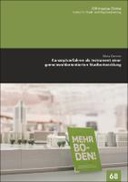Explore

Konzeptverfahren als Instrument einer gemeinwohlorientierten Stadtentwicklung
Mona Gennies
2021
0 Ungluers have
Faved this Work
Login to Fave
Who should profit from urban planning? An increasing number of stakeholders currently demand that planning policy leads to added value for the entire urban society and not just for individual groups: Designing for the common good! One instrument of public real estate policy that negotiates the common good could be a conceptual allocation of public property (Konzeptverfahren). This instrument allows cities to allocate their land based on the quality of the idea for development and use instead of price-based bidding. In public invitations to tender, municipalities define a set of criteria that applicants can or must meet. The aim of this publication is to evaluate the orientation of such tenders towards the common good using a list of criteria compiled from the following existing assessments: The Federal Building Code (Baugesetzbuch); the city yield (Stadtrendite); a proposed federal policy to support not-for-profit housing companies (Wohngemeinnützigkeit); the Common Good Balance Sheet (Gemeinwohlökonomie); the Better-Life-Index (Wohlstandsforschung) and the common good criteria as defined in the federal tax code (Gemeinnützigkeit nach Abgabenordnung). Although there may be some variations in definitions of common good, at the core of these assessments are social criteria, ecological sustainability, and opportunities for participation. Beside these dominant categories, each assessment is supplemented by less common criteria which are grouped into six additional categories, giving an overview of how the common good is currently defined. This paper examines 28 invitations to tender based on the conceptual allocation of public property (Konzeptausschreibungen). Of these 28 invitations, each from a different German city, it was found that all contained, to some extent, the criteria for forming common good. As such, these tenders can be considered as supporting the common good. This script finds, however, that the categories participation, education and health should resonate more strongly in future tenders. The instrument (Konzeptverfahren) offers municipalities the opportunity to set development goals that are based on local needs and public interest criteria. But, as the comparison shows, there are significant differences between tendering procedures. Therefore, it should not be concluded that tendering based on the conceptual allocation of public property guarantees public interest-oriented urban development.
This book is included in DOAB.
Why read this book? Have your say.
You must be logged in to comment.
Rights Information
Are you the author or publisher of this work? If so, you can claim it as yours by registering as an Unglue.it rights holder.Downloads
This work has been downloaded 71 times via unglue.it ebook links.
- 71 - pdf (CC BY) at OAPEN Library.
Keywords
- Common good
- conceptional allocation
- Public interest
- public property
- Real estate
- Regional & area planning
- Urban & municipal planning
Links
DOI: 10.14279/depositonce-10398Editions

